Development of Balinese Cosmetology Marketplace Application on Android Based
on
JURNAL ILMIAH MERPATI VOL. 11, NO. 3 DECEMBER 2023 p-ISSN: 2252-3006
e-ISSN: 2685-2411
Development of Balinese Cosmetology Marketplace Application on Android Based
Ni Kadek Ayu Wirdiania1, Anak Agung Kompiang Oka Sudanaa2 aInformation Technology, Udayana University, Indonesia email: 1ayuwirdiani@unud.ac.id, 2agungokas@unud.ac.id
Abstrak
Penampilan merupakan hal utama bagi wanita. Penampilan yang menarik membuat seseorang menjadi lebih percaya diri. Hal ini menunjukkan kebutuhan akan jasa personal beautification masih tinggi peminatnya, dan menjadi peluang usaha kecantikan yang menjanjikan. Selain untuk perawatan harian, usaha salon dan tata rias juga banyak permintaan pada acara-acara tertentu seperti wisuda, perkawinan serta acara tari. Di era pandemi, sebagian besar orang malas keluar rumah untuk melakukan perawatan, mereka ingin yang praktis dan bisa dipesan secara online. Berdasarkan hal tersebut maka dibuatlah solusi berupa aplikasi online agar orang dapat melakukan pemesanan tata rias maupun perawatan tubuh di rumah. Pada aplikasi ini akan terdapat tiga user yaitu admin salon, customer dan staff terapis. Hasil pengujian dengan menggunakan metode black box yang diuji oleh customer sebanyak 15 orang menghasilkan persentase 87.96% yang berarti aplikasi sangat layak dikembangkan. Hasil pengujian dengan usability testing menunjukkan bahwa indikator satisfication sebagai indikator tertinggi.
Kata kunci: aplikasi tata rias, online, usaha salon, Bali.
Abstract
Appearance is the main thing for women. An attractive appearance makes a person more confident. This shows that the demand for personal beautification services is still high, and is a promising beauty business opportunity. Apart from daily grooming, salon and cosmetology businesses are also in high demand at certain events such as graduations, weddings and dance events. In the pandemic era, most people are reluctant to leave the house to get treatment, they want something practical that can be ordered online. Based on this, a solution was created in the form of an online application so that people can order make-up and body care at home. In this application there will be three users, namely salon admin, customer and therapist staff. The test results using the black box method which were tested by 15 salon customers produced a percentage of 87.96%, which means the application is very suitable for development. The test results with usability testing show that the satisfaction indicator is the highest indicator.
Keywords : cosmetology application, online, salon business, Bali.
Appearance is the main thing for a woman. An attractive appearance will make someone more confident. Women tend to focus more on self-care from face and hair to skin. This shows that demand for personal beautification services is still quite high, and the beauty business opportunity is a promising prospect. Apart from daily care, salon and cosmetology businesses also have many requests for make-up for certain events such as graduations, weddings, parties, dance events and so on. Cosmetology businesses also rent clothes, especially for events such as weddings and dance events.
In this pandemic era, most people are reluctant to leave the house for treatment especially for traditional events such as weddings, they want something practical that can be ordered online. Based on this, a solution will be created so that people can order make-up and
body care at home. In this research, an online application will be created for cosmetology businesses in Bali.
This application presents features that can make it easier for users to choose the desired service. Research regarding marketplace applications has been carried out before such as : research [1] conventional salon marketing using brochures, posters, and flyers costs quite a lot of money and it is difficult to find information about the promotions and discounts offered by the salon. The design is made with ordering features, services, transaction history, and notifications. The results obtained from this research that the application makes it easier for salons to promote and speed up the ordering process. In research [2], the method of ordering services is done by coming directly to the salon which causes inefficient use of time. The features found in the online salon application are ordering and service lists. The results of the research are that customers can order salon services at home or the desired place and customers know the price of the services that need to be paid. Research [3] on salon bookings still uses a simple method of recording customer data so that data is easily lost because it is not neatly arranged. The research was designed with a booking feature. The results of this research help make the process of ordering services easier for customers so that customers do not need to come directly to the salon.
Research [4] shows that customer care data management is still done manually, namely recorded in books, making it difficult for employees to manage customer data and make salon reports, customers have to come directly to the salon to make orders. The application is designed with reservation and maintenance list features. The research results show that the application makes it easier for customers to make reservations, and admins can disseminate promotional information. Research [5] shows that salon service management is still not computerized, so it is difficult to find out the monthly and annual income obtained from all salon services. The features contained in the application are salon services, daily income reports, and service-type income reports. The results of the research show that a system can manage services so that income reports are more organized. Research [6] shows that ordering salon services is still manual via the WhatsApp application or consumers come directly to the salon, so it takes a lot of time. The application has a service and maintenance booking feature. The results of this research with the system can make it easier for consumers to order services available at the salon.
Research [7] stated that the decline in salon turnover was caused by the COVID-19 pandemic because salons had not been able to adapt to situations and conditions such as the pandemic so salons could not reach a wide range of customers. The research design contains tutorial or consultation features. The results of the research are that the application can connect employees with customers so that customers can carry out their care at home by providing tutorials or consultations. Research [8] shows that salons still use manual methods to carry out the customer data collection process, making it difficult for employees to process data on customers who order at the salon. The features resulting from this research are orders, order reports, maintenance data collection, and customer data collection. The results of this research are that the application can make it easier for employees to input data and store data so that it can improve the quality of information, make it easier to record inventory data, facilitate the process of making reports and checking data to produce reports that are faster and more accurate by the data in the system.
From the research presented, it can be concluded that designing and creating a Balinese Cosmetology Business Application can simplify the process of booking services, getting information about the services available at the salon, and getting service sales reports. The difference in this research is that there is a salon category feature that displays the salons with the best ratings and the newest salons, a near me feature that is useful for finding the nearest salon, a rating and review feature, a report feature that is useful for displaying salon income data.
Research Methods contain an explanation of the research process used on the Balinese Cosmetology Marketplace Application. Research methods used in conducting research can be seen in Figure 1.
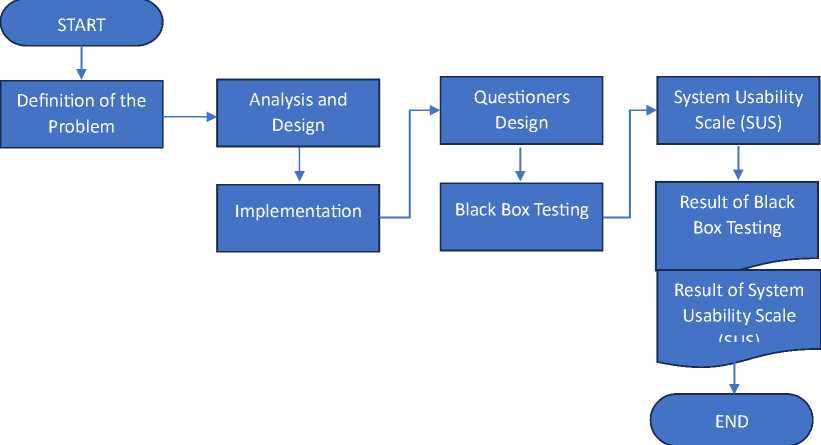
Figure 1. Research Methods
Figure 1 shows the research method used. The research method starts with formulating problems, analyzing and designing, implementing, performing questionnaires and conducting system tests, finally getting test results. System Overview is how the application works in general shown in Figure 2 below:

Figure 2. System Overview
Figure 2 is a system overview of the Salon Marketplace Application. Users are application users who have registered with the Salon Marketplace Application. Users can register their salon business in the application. Registered businesses are saved in the
database. Application users can search for the desired salon based on salon data that has been registered in a system that can be accessed directly by a smartphone device user.
The use case Diagram is a diagram that connects users and admins on the salon booking application. The salon booking application use case design can be seen in Figure 3.
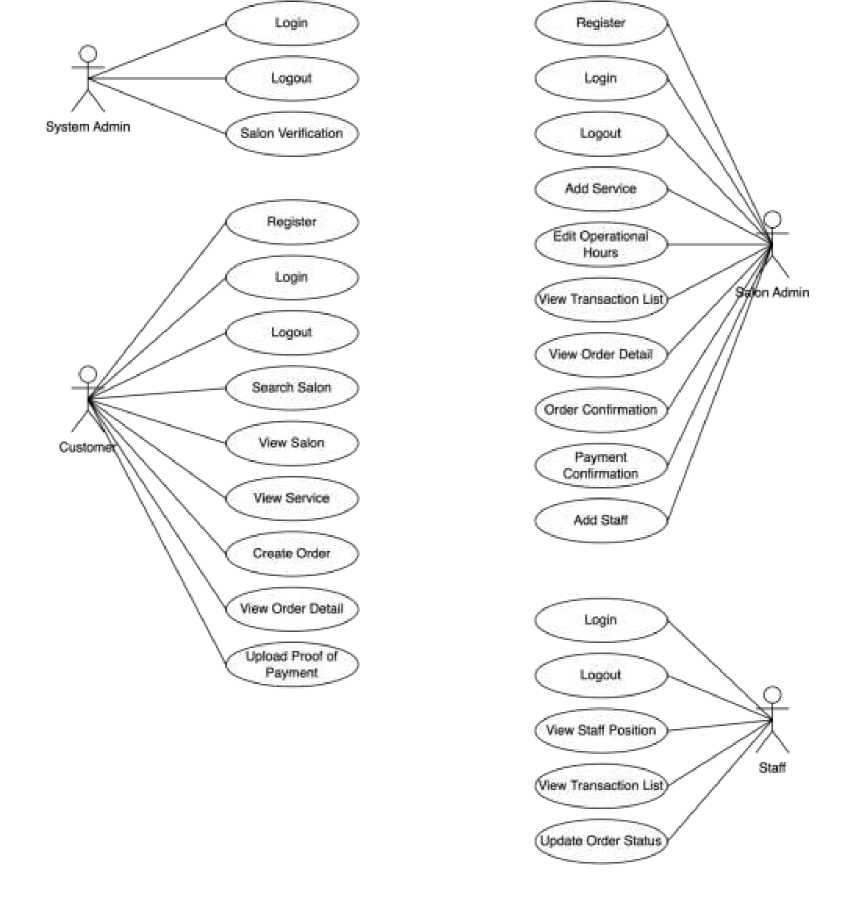
Figure 3. Use Case Diagram
Figure 3 is a use case of the Balinese Cosmetology Application which consists of four entities namely salon admin, customer, staff, and system admin. Salon admins can register their salons first and the system admin does the verification. Customers can do this by ordering services, the salon admin will get a notification of services ordered by customers and staff who will carry out services ordered by customers.
A context diagram depicting the system flow of the Online Cosmetology Application can be seen in the figure below.
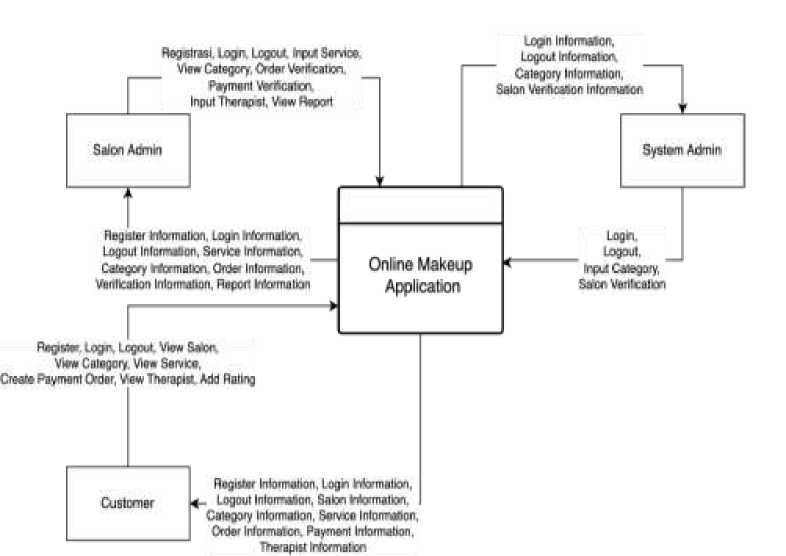
Figure 4. Online Makeup Application Context Diagram
Figure 4 is a context diagram of the Bali Makeup application, where there are three entities in it, namely system admin, salon admin, and customer. Customers can input the Register Data, Login Data, Salon Data Info, Service Data Info, Order Data, Transaction Data, Payment Data, Therapist Data Info, Rating Data, and customers will get Register Info, Login Info, Salon Data, Service Data, Order Info, Transaction Info, Payment Info, Therapist Info, Rating Info. Salon admins can input Register Data, Login Data, Service Data, Order Data, Transaction Data, Payment Data, Therapist Data, and salon admins will get Register Info, Login Info, Service Info, Order Info, Transaction Info, Payment Info, Therapist Info. The system admin can input Login Data, Salon Data, the system admin will get Login Info, Salon Registration Info.
According to Haryawan, make-up is the art of using cosmetic ingredients to create the face of a role and must pay attention to lighting and distance from the audience, while dress code is all the clothing and equipment worn on stage. Costumes are classified into five parts, namely basic clothing, legs, body, head and equipment. Make-up is an art that aims to beautify the face by highlighting the parts that are already beautiful and disguising or covering up flaws in the face. Makeup also aims to support a person's self-confidence [9].
A beauty salon is a business place that operates in the field of beauty services related to beauty care and cosmetics for men and women. A beauty salon is a place to beautify the body by providing care related to skin health, hair beauty, facial aesthetics, foot care, nail care, waxing or other hair removal, and so on related to body beauty services [10].
E-commerce can be interpreted as the concept of implementing E-business as a strategy for buying and selling goods and services via electronic networks and usually involves electronic data transactions, automatic inventory management systems and automatic data collection systems. This is due to the increasingly rapid development of information technology both in terms of efficiency and security, giving rise to ideas for making information technology a medium for marketing, promotions and even data transactions which are considered to be more efficient and make buying and selling transactions easier [11].
A use case diagram is a depiction of a system from the perspective the user of the system so that making use cases is more focused on the functionality of the system, not based on the flow or sequence of events. Use cases define what will be processed by the system and its components [12]. Use cases work by using scenarios which are descriptions of sequences or steps that explain what the user does to the system and vice versa. Use cases identify the functionality of the system, user interactions with the system and the relationship between users and system functionality.
Data Flow Diagrams or Data Flow Diagrams (DFD) are modeling tools that describe a system as a network of functional processes that are connected by data flow, either manually or computerized [13]. Data Flow Diagrams have 2 levels in system design or depiction, namely level 0 and level 1. Level 0 is a description of the system as a whole, which is then broken down into smaller systems. The results of solving at level 0 will be divided into smaller parts, this process is DFD level 1. The level 1 diagram functions to describe or explain the process and data flow contained in the level 0 diagram.
The Black Box Testing method is a method used to test software without having to pay attention to the details of the software. This test only checks the output value based on the respective input value [14]. Black box testing aims to find incorrect functions, interface errors, data structure errors, performance errors, initialization and termination errors [15].
A system usability scale is a measurement tool used to measure the level of usability of a system [16]. SUS is a user test method that provides a reliable "quick and dirty" measuring tool [17]. The SUS consists of ten questions, each question has a five-point scale. There are five positive statements and five negative statements [18].
The features contained in the Balinese Cosmetology Application have different functions can be seen as follows.
The main features that can be used by users in the cosmetology marketplace application can be seen in Figure 5. Figure 5 shows the transaction list and Near Me feature interface for the user. The transaction list contains a list of transactions for the salon originating from customers. The transaction list contains a list of user transactions whereas the transaction list menu contains filters that function to sort orders done by the user. The detailed transaction list contains a list of user transactions so that users can know the status of the order. The Near Me menu functions to see the salon closest to the user. Users can also see the status of the salon, whether the salon is open or closed by looking at the color of the icon.
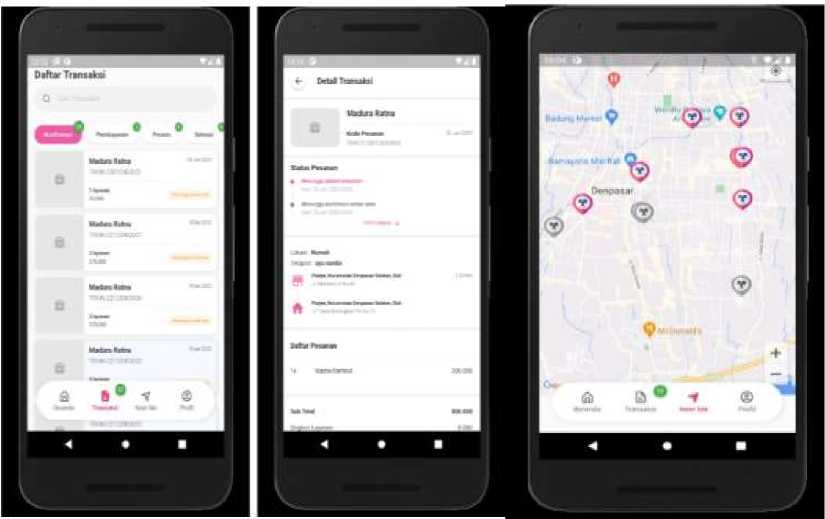
Figure 5. Transaction List Menu and Near Me Feature User Interface
The results of the Black Box questionnaire which was carried out with 15 respondents are the results of whether the system runs according to expectations or not. The results of the Black Box questionnaire can be seen in Figure 6.
120
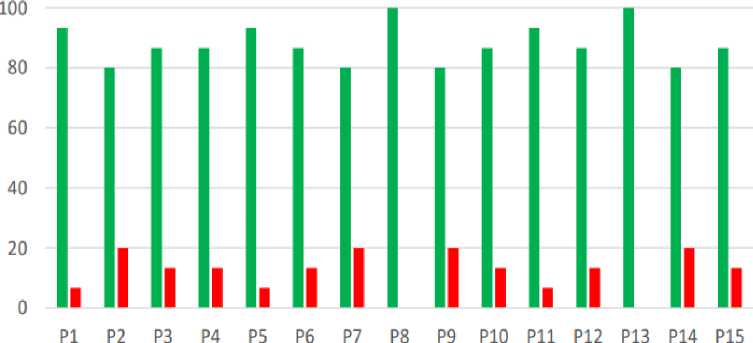
■ Ya BTidak
Figure 6. Black Box Testing Results
Figure 6 explains the percentage of yes answers and no answers to each question asked. The green color shows that the respondent answered the question with a yes answer for each question and the red color shows that the respondent answered the question with a no answer for each question asked. The percentage of testing using the Black Box Method obtained a percentage of yes answers of 87.96% and no answers of 12.04%, which means that the Balinese Cosmetology Application is suitable for use.
Data from the System Usability Scale calculation results were obtained after the original data from Q1 to Q10 were added up using the System Usability Scale calculation tool and multiplied by 2.5. The following are the results of calculations using the System Usability Scale which can be seen in Table 1.
Table 1. System Usability Scale Calculation
|
Score Results Calculate for Customer data |
Sum |
Score | |||||||||
|
Q1 |
Q2 |
Q3 |
Q4 |
Q5 |
Q6 |
Q7 |
Q8 |
Q9 |
Q10 |
Sum x 2.5 | |
|
3 |
2 |
2 |
2 |
4 |
3 |
3 |
2 |
3 |
2 |
26 |
68 |
|
4 |
2 |
3 |
2 |
3 |
3 |
2 |
3 |
3 |
1 |
26 |
65 |
|
3 |
3 |
2 |
2 |
3 |
3 |
2 |
3 |
3 |
1 |
25 |
63 |
|
3 |
3 |
3 |
2 |
4 |
3 |
3 |
3 |
3 |
2 |
29 |
73 |
|
3 |
3 |
3 |
2 |
4 |
3 |
2 |
2 |
2 |
1 |
25 |
63 |
|
3 |
2 |
3 |
2 |
4 |
3 |
2 |
2 |
2 |
1 |
25 |
63 |
|
4 |
3 |
2 |
2 |
4 |
3 |
2 |
2 |
1 |
2 |
25 |
63 |
|
4 |
2 |
2 |
2 |
4 |
4 |
3 |
3 |
1 |
1 |
26 |
65 |
|
4 |
2 |
3 |
3 |
4 |
3 |
2 |
2 |
2 |
2 |
27 |
68 |
|
3 |
1 |
2 |
2 |
4 |
3 |
2 |
2 |
1 |
1 |
21 |
53 |
|
Average score |
65 | ||||||||||
Table 1 shows the total questionnaire results for Customer data. The score results are obtained by the addition from Q1 to Q10 where the result will be multiplied by 2.5.
NPS:
Detractor
Passive
Promoter
Acceptable:
Not Acceptable
Margins ι
Acceptable
Adjective:
Worst Imaginable
Poor
OK
Good Excellent Best Imaginable ι ■■■j^
Grade:
F
D
C B
A
l____l____l____i____l____l____l__l_____I_____I I
SUS Score: O 10 20 30 40 50 60 70 80 90 100
Figure 7. Interpretation of System Usability Scale Scores
Figure 7 is an interpretation of the SUS score for the Balinese Cosmetology application which was assessed by 10 respondents with a score of 65. The interpretation of this SUS score is: this SUS score means this application at the customer module, received a C grade. This SUS score can also be interpreted as OK in the adjective ratings category. This SUS score can also be interpreted in the marginally acceptable category in acceptability interpretation. This SUS score can also be interpreted in NPS, so respondents will tend to be passive, that is, not as promoters or detractors.
The Black Box testing that was carried out obtained a yes answer with a percentage of 87.96% and a no answer of 12.04%, this was due to problems in application testing. Testing constraints and solutions that can be provided can be seen in Table 2.
Table 2. Black Box Testing Analysis
|
No |
Feature |
Constraint |
Solution |
|
1 |
Register |
1 respondent failed to register because he was wrong to enter a password |
Fill in the "see password" icon |
|
2 |
Login |
3 respondents failed to log in because they were wrong enter password |
Fill in the "see password" icon |
|
3 |
Home |
2 respondents could not find the home button |
Change the icon to something more familiar. |
|
4 |
Category |
2 respondents did not know how to use the category feature. |
Provide more explanation and detail the Category |
|
5 |
Best Ratings |
1 respondent did not know about the salon with the best rating |
Add and display the rate number in the salon column |
|
6 |
Newest Salon |
2 respondents did not understand about Newest Salon because there is no such thing that shows that a salon is the newest salon. |
Add and display the salon date at the time registered. |
|
7 |
List Transaction |
3 respondents did not understand how to use List Transaction menus. |
Provides filters on the List Transaction menus. |
|
8 |
Near Me |
2 respondents could not find the Near Me Salon because the map cannot be zoomed in and zoomed out. |
Fixed the map so it can be accessed zoom in and zoom out. |
|
9 |
Salon Time Services |
1 respondent did not find the list of Salon Time Services. |
Give a sign if the salon is closed. |
|
10 |
Profile |
2 respondents could not press the Profile button. |
Explain below the icon menus. |
|
11 |
Notification |
3 respondents did not know the difference between New Notifications and Old Notification. |
Provide different colors for Notifications that have not yet been read. |
|
No |
Feature |
Constraint |
Solution |
|
12 |
Ratings and Reviews |
2 respondents did not find a menu to give Ratings and Reviews of the salon. |
Provide more explanation of the menus where the customer gives a Rating and Reviews for the salon. |
Table 2 is a table that explains the obstacles encountered by 15 respondents when using the application and provides solutions to problems which is useful for evaluating the functionality of the application features.
Conclusions that can be drawn from this research are based on testing with the Black Box testing produced a percentage of 87.96% of respondents with a yes answer that the application was running well according to its function and suitable for use. The System Usability Scale method obtained a score of 65 with a grade of C which means OK category in adjective ratings, marginally category acceptable, and classified as passive in NPS. It shows that the application can make it easier for users to book salons and find the desired salon. This research is still possible to develop by adding a payment method with a virtual account to speed up the payments and also chat features to interact between users with the salons. This salon feature it just not only for make-up market service also for market salon services.
References
-
[1] A. D. Ratnasari, A. Saputra, G. Gunawan, and C. Sylvia, “Rancang Bangun Website
Marketplace ‘E-Salon,’” KOMIK (Konferensi Nas. Teknol. Inf. dan Komputer), vol. 3, no. 1, pp. 213–219, 2019, doi: 10.30865/komik.v3i1.1591.
-
[2] A. Setianni and R. Syahputri, “Pesona: Sistem informasi pemesanan salon online
berbasis location based service,” Pros. Semin. Nas. 2019 Sinergitas Multidisiplin Ilmu Pengetah. dan Teknol., vol. 2, no. 2011, pp. 1–7, 2019.
-
[3] Anharudin and L. F. B. Dewi, “Aplikasi E-Booking Salon Berbasis Web Pada Dhiva
Zahra Salon Dan Spa Cilegon – Banten,” Prosisko, vol. 6, no. 2, 2019.
-
[4] S. A. S. Fitriana et al., “Gaya hidup dan cara mengatasi acne (studi pada mahasiswa
universitas airlangga),” J. Farm. Komunitas, vol. 5, no. 2, pp. 62–8, 2018.
-
[5] S. Iyus, “Sistem informasi manajemen jasa perawatan kecantikan di salon anda,” J.
Teknol. Inf. Vol. 4 No. 1, April 2016 ISSN 2338-1434, vol. 4, no. 1, pp. 1–16, 2016.
-
[6] D. S. Sitinjak, T. H. Sinaga, and E. Rahayu, “E-Booking Salon Kecantikan Menggunakan
Metode Ucd ( User Centered Design ) Pada Maria Studio Beauty,” J. Tek. Inf. dan Komput., vol. 4, no. 2, p. 183, 2021, doi: 10.37600/tekinkom.v4i2.379.
-
[7] A. Dewantara, R. K. Dewi, and R. S. Sianturi, “Perancangan User Experience Aplikasi
Salon Online dalam Menghadapi Pandemi di Lina Salon,” J. Pengemb. Teknol. Inf. dan Ilmu Komput., vol. 6, no. 5, pp. 2478–2487, 2022.
-
[8] I. Rahayu, A. Primawati, and A. A. R. Awaludin, “Perancangan Aplikasi Pemesanan Jasa
Salon Tyas Kampung Gedong Berbasis Java,” J. Ris. dan Apl. Mhs. Inform., vol. 4, no. 01, pp. 181–186, 2023, doi: 10.30998/jrami.v4i01.7155.
-
[9] L. R. R. Ningsih, I. A. Haris, and K. R. Suwena, “Studi Komparatif Kepuasan Konsumen
Salon Davina Sumberkima Dengan Salon Lely Sumberkima Di Kecamatan Gerokgak Kabupaten Buleleng,” J. Pendidik. Ekon. Undiksha, vol. 11, no. 1, p. 238, 2019, doi: 10.23887/jjpe.v11i1.20140.
-
[10] LINDA RESTY BUNGASALU, “Pusat Pengembangan Kecantikan Wanita Di Yogyakarta,” Tugas Akhir Sarj. Strat., pp. 17–50, 2010.
-
[11] Romindo and Muttaqin, e-Commerce: Implementasi, Strategi dan inovasi, 1st ed. Yayasan Kita Menulis, 2019.
-
[12] L. Setiyani, “Desain Sistem : Use Case Diagram Pendahuluan,” Pros. Semin. Nas. Inov.
Adopsi Teknol. 2021, no. September, pp. 246–260, 2021, [Online]. Available:
https://journal.uii.ac.id/AUTOMATA/article/view/19517.
-
[13] R. A. Atmala and S. Ramadhani, “Rancang Bangun Sistem Informasi Surat Menyurat Di Kementerian Agama Kabupaten Kampar,” J. Intra Tech, vol. 4, no. 1, pp. 27–38, 2020.
-
[14] W. N. Cholifah, S. M. Sagita, and S. Knowledge, “PENGUJIAN BLACK BOX TESTING PADA APLIKASI ACTION & STRATEGY BERBASIS ANDROID,” vol. 3, no. 2, pp. 206– 210, 2018.
-
[15] F. C. Ningrum, D. Suherman, S. Aryanti, H. A. Prasetya, and A. Saifudin, “Pengujian Black Box pada Aplikasi Sistem Seleksi Pemenang Tender Menggunakan Teknik Equivalence Partitions,” J. Teknol. Sist. Inf. dan Apl., vol. 2, no. 4, p. 130, 2019, doi: 10.32493/jtsi.v2i4.3708.
-
[16] H. Henriyadi and R. Mulyati, “USABILITY TESTING Sistem Informasi: Studi kasus pada Aplikasi Repositori Publikasi Badan Penelitian dan Pengembangan Pertanian,” J. Perpust. Pertan., vol. 23, no. 2, p. 54, 2016, doi: 10.21082/jpp.v23n2.2014.p54-63.
-
[17] F. G. Sembodo, G. F. Fitriana, and N. A. Prasetyo, “Evaluasi Usability Website Shopee Menggunakan System Usability Scale (SUS),” J. Appl. Informatics Comput., vol. 5, no. 2, pp. 146–150, 2021, doi: 10.30871/jaic.v5i2.3293.
-
[18] R. R. Isnanto, A. A. Zahra, and E. D. Widianto, “Analisis Kinerja Pengenalan Telapak Tangan Menggunakan Ekstraksi Ciri Principal Component Analysis (PCA) dan Overlapping Block,” Sci. J. Informatics, vol. 2, no. 2, p. 137, 2016, doi:
10.15294/sji.v2i2.5082.
Development of Balinese Cosmetology Marketplace Application on Android Based (Ni Kadek 233
Ayu Wirdiani)
Discussion and feedback